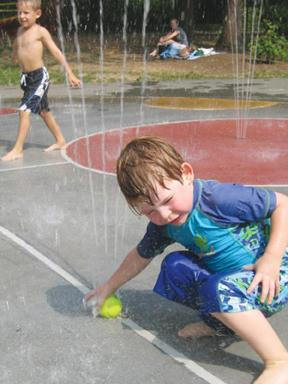 |
|
Support for Sprayparks Not Quite Unanimousby KRISTEN ARMSTRONG, Staff Writer
|
|
| What could be a more
all-American way for a youngster to spend a lazy, humid summer afternoon
than enjoying the spritzes from one of the Arlington government-built
mini-water parks, called “spraygrounds”? That's not the sentiment of Wendy Griswold of Lyon Village, who has been on a crusade against the parks. “I think there are a lot of hazards associated with it, and kids would better off playing in a lawn sprinkler,” Griswold said in a recent interview. Griswold and county government officials have sparred over the spraygrounds, located at Hayes Park and Lyon Village Park. Her complaints run the gamut - from the parks' waste of water to a lack of supervision that allows kids to run through the facilities naked, pooping and pidddling along the way. “There are better ways to get wet,” Griswold said. The sprayparks, she said, “are an embarrassment for Arlington.” Government officials say they have tried to respond to Griswold's concerns. They say that, aside from a few complaints, the public has embraced the parks. “Basically how they come about is the citizens ask us to install them,” said Arlington parks and natural resources division chief Steve Temmermand. “The parks were opened with community knowledge and participation.” The Hayes Park spraypark opened in 2005, with the Lyon Village spraypark opening last year. Since there are no public outdoor pools in Arlington, the spraygrounds are a good substitute, and have been a hit, Temmermand said. “The general reaction is that everybody loves it,” he said. The county does not track daily water usage of the parks, but officials estimate that about 30,000 gallons of water are used per day during the approximately 100 days (from Memorial Day to Labor Day) the spraygrounds are open. While county officials recognized that they'd “definitely be subject to questioning by those wanting to be most green, and those wanting to point out contradictions,” Temmermand said, officials believe that the spraygrounds may not use as much water as people might think. The spraypark “is button-activated and goes off for four minutes,” Temmermand said. “So, it could be activated and running all day, in theory, but that would mean someone would have to be there pushing the button every four minutes, which isn't likely.” But in Griswold's opinion, the button feature doesn't seem to cut down on the parks' water wastage. “I live across the street from Lyon Village, and there's almost always someone in there. There are people who it just it to watch the water run,” she said. Although the water is not recaptured, it does not go into the normal sewage system. Rather, it goes into the storm sewer, flowing into to the Potomac River and the Chesapeake Bay, Temmermand said. Were the region to experience a serious drought, “we would recommend that Parks, Recreation and Cultural Resources turn off the sprayparks temporarily,” said David Hundelt, bureau chief for water, sewers and streets for the county government. A trigger for turning off the water would likely be if the county government needed to release water from upstream reservoirs to meet demand. In the last quarter-century, that has only occurred twice, in 1999 and 2002. A third neighborhood has expressed interest in having a spraypark installed, county government officials said. … See more on this story, including video, at www.sungazette.net. |
 Max Mobley and Kyle Eremia enjoy the late summer sun at one of Arlington's sprayparks. (Photo by Kristen Armstrong) |